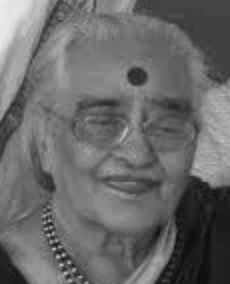Biography:Satyavati Motiram Sirsat
Satyavati Motiram Sirsat | |
|---|---|
 | |
| Born | Satyavati Motiram 7 October 1925 Karachi |
| Died | 10 July 2010 |
| Occupation | Cancer researcher |
Satyavati Motiram Sirsat (7 October 1925 – 10 July 2010) was an Indian cancer researcher.
Early life
Sirsat was born in Karachi, but lived in various cities as a girl.[1] Her Gujarati parents were Theosophists, and she attended Kalakshetra, a theosophy-based school in Chennai, run by George Arundale and Rukmini Arundale.[2] She earned a bachelor's degree in microbiology at St. Xavier's College in 1947, and completed doctoral studies in pathology at Tata Memorial Hospital for Cancer in 1958. She pursued further studies in electron microscopy in London in 1958.[3]
Career
Sirsat began the first electron microscopy laboratory to study cancer in India. She was founder and president of the Electron Microscope Society of India. Her research, which focused on oral submucous fibrosis, was published in Nature,[4] Carcinogenesis,[5] Tumori Journal,[6] Journal of Cell Science,[7] Journal of Investigative Dermatology,[8] and other scholarly journals.[9] She served on the editorial boards of other journals, including the Indian Journal of Experimental Biology Education, and Journal of Biosciences. She became a fellow of the Indian Academy of Sciences in 1975.[10]
Sirsat retired from research in 1985, and became a social worker and medical ethicist, and took an interest in ayurvedic interventions as cancer treatment.[11] She was active in hospice work,[3] and wrote Death, the Final Freedom (1998) about this work.[12]
Sirsat advised aspiring scientists, "Be honest to your work and true to yourself. Be disciplined. Never disparage the work of your fellow scientists. Be observant — never distort your log or show records to fit a preconceived theory. Above all, life is to learn — so learn, learn and learn!"[2]
Personal life
Satyavati Motiram married fellow cancer researcher M. V. Sirsat.[2] She died from cancer in 2010, aged 84 years.[3][13]
References
- ↑ Singh, Avni (2019-03-25). "Satyavati M Sirsat: Pioneer In Indian Cancer Research | #IndianWomenInHistory" (in en-US). https://feminisminindia.com/2019/03/26/satyavati-m-sirsat-cancer-research/.
- ↑ 2.0 2.1 2.2 Sirsat, Satyavati M. "Exploring Nature's Secrets" in Rohini Godbole and Ram Ramaswamy, eds., Lilavati's Daughters: The Women Scientists of India (Indian Academy of Sciences 2008): 310-313.
- ↑ 3.0 3.1 3.2 Chattopadhyay, Anjana (2018) (in en). Women Scientists in India: Lives, Struggles & Achievements. National Book Trust, India. ISBN 978-81-237-8144-0. https://nbtindia.gov.in/writereaddata/freebooks/pdf/Women%20Scientists%20in%20India.pdf.
- ↑ Sirsat, Satyavati M.; Kandarkar, S. V. (June 1968). "Histological changes in the oral mucosa of the wistar rat treated with commercial lime (calcium hydroxide)--an optical and submicroscopic study" (in en). British Journal of Cancer 22 (2): 303–315. doi:10.1038/bjc.1968.38. ISSN 1532-1827. PMID 5660135.
- ↑ Kalimi, Ghulam H.; Sirsat, Satyavati M. (1984). "The relevance of gap junctions to stage I tumor promotion in mouse epidermis". Carcinogenesis 5 (12): 1671–1677. doi:10.1093/carcin/5.12.1671. ISSN 0143-3334. PMID 6499119. https://doi.org/10.1093/carcin/5.12.1671.
- ↑ Bhisey, Rajani A.; Sirsat, Satyavati M. (1986-12-01). "Ultrastructural Analysis of Epidermal Hyperplasia Induced by Multiple 12-0-Tetradecanoyl-Phorbol-13-Acetate (TPA) Treatment of Mouse Skin" (in en). Tumori Journal 72 (6): 643–650. doi:10.1177/030089168607200618. ISSN 0300-8916. PMID 3810868. https://doi.org/10.1177/030089168607200618.
- ↑ Rangan, S. R. S.; Sirsat, Satyavati M. (1962-03-01). "The Fine Structure of the Normal Chorio-Allantoic Membrane of the Chick-Embryo" (in en). Journal of Cell Science s3-103 (61): 17–23. doi:10.1242/jcs.s3-103.61.17. ISSN 0021-9533. https://jcs.biologists.org/content/s3-103/61/17.
- ↑ Sirsat, Satyavati M.; Ketkar, M.B. (April 1966). "Influence of Doca on Induced Epidermal Cancers in Mice*". Journal of Investigative Dermatology 46 (4): 331–340. doi:10.1038/jid.1966.53. ISSN 0022-202X. PMID 5936038.
- ↑ Sirsat, Satyavati M.; Pindborg, J. J. (1967). "The Vascular Response in Early and Advanced Oral Submucous Fibrosis" (in en). Acta Pathologica et Microbiologica Scandinavica 70 (2): 179–184. doi:10.1111/j.1699-0463.1967.tb01280.x. ISSN 1600-0463. PMID 6050371. https://onlinelibrary.wiley.com/doi/abs/10.1111/j.1699-0463.1967.tb01280.x.
- ↑ "Deceased Fellows". https://fellows.ias.ac.in/listing/a?fellowship.type=deceased&profile.sex=F.
- ↑ Vaidya, Ashok; Vaidya, Rama; Vaidya, Vidita; Gunvanti; Joshi, Bharati; Mody, Jyoti; Joshi, Jayashree; Amonkar, Ashok et al. (2003). "Spontaneous or Induced Regression of Cancer: A Novel Research Strategy for Ayurvidya". Ancient Science of Life 22 (3): 75–83. ISSN 0257-7941. PMID 22557089.
- ↑ Sirsat, Satyavati M. (1998) (in en). Death, the Final Freedom. Gujarat Sahitya Prakash. https://books.google.com/books?id=jC9MHQAACAAJ.
- ↑ Bhisey, Rajani A. (2011). "Satyavati M. Sirsat (1925–2010)". Current Science 101 (7): 964–965. ISSN 0011-3891. https://www.jstor.org/stable/24079137.
 |

